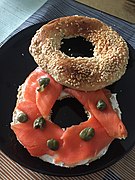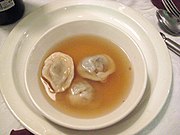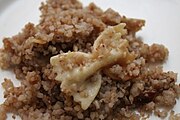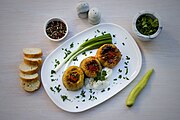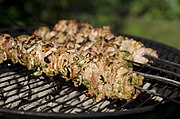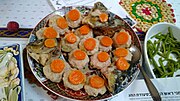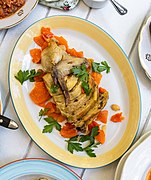Ashkenazi Jewish cuisine
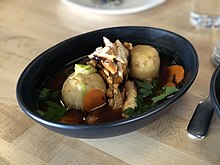
Ashkenazi Jewish cuisineis an assortment of cooking traditions that was developed by theAshkenazi Jewsof Central, Eastern, Northwestern and Northern Europe, and their descendants, particularly in theUnited Statesand other Western countries.
Ashkenazi Jewish foods have frequently been unique to Ashkenazi Jewish communities, and they frequently consist of local ingredients (such asbeets,cabbage,andpotato), all of which are generally prepared in accordance with the laws ofkashrut.Some of these ingredients have not been popular in local or neighbouring non-Jewish communities due to a history of limited interaction between Ashkenazi Jews and non-Jews.[citation needed]
The cuisine is largely based on ingredients that were affordable to the historically poor Ashkenazi Jewish community of Europe, and it is frequently composed of ingredients that were readily available and affordable in the regions and communities of Europe in which Ashkenazi Jews lived. Some ingredients were considered less desirable than other ingredients, such asbrisket,chicken liver,andartichokes,among other ingredients, and as a result, these items were rarely used bygentileneighbours of Ashkenazi Jews.
Meat is ritually slaughtered in theshechitaprocess, and it is also soaked and salted. Meat dishes are a prominent feature ofShabbat,festivals, and celebratory meals. Braised meats such asbrisketfeature heavily, as do root vegetables such as potatoes, carrots, and parsnips which are used in such dishes aslatkes,matzo ball soup,andtzimmes(a braised fruit and vegetable dish which may also contain meat). Cooked, stuffed and baked vegetables such asstuffed cabbageand, in some regions, stuffed peppers are central to the cuisine.
Due to the lack of availability ofolive oiland other fats which are commonplace inJewish cooking,rendered fat from leftoverpoultryskins (gribenes) calledschmaltzis used infleishig(meat) dishes, whilebutteris traditionally used inmilchig(dairy) dishes.[1][2]Since the advent of mass-produced vegetable oils (particularly in the United States and Canada) such ascanola oil,many baked goods have been made with oils rather than butter, so as to render thempareve.
History[edit]
The cuisine of the Ashkenazi Jews is reflective of their journey fromCentraltoEastern Europeand then to theAmericasandIsrael.[3]Ashkenazi Jews are aJewish diasporapopulation which coalesced in theHoly Roman Empirearound the end of the first millennium CE. This population progressively migrated eastward, and established population centres in thePolish–Lithuanian Commonwealth(a nation which then consisted of territories currently located in parts of present-dayBelarus,Estonia,Latvia,Lithuania,Moldova,Poland,Russia,Slovakia,andUkraine).[4]Ashkenazi communities have also historically been present in theBanat,a region in central and eastern Europe that consists of parts of present-daySerbia,Romania,andHungary.As a result, the cuisine of Ashkenazi Jews was highly regional in the past, and has also been influenced by a diverse range of European cooking traditions, including German, French, Italian, Slavic, and Ottoman cuisines.
A common refrain is that the food of Ashkenazi Jews is the food ofpoverty.Indeed, Jews in Europe generally lived at the sufferance of the gentile rulers of the lands in which they sojourned, and they were frequently subjected toantisemiticlawsthat, at certain times and in certain places, limited their participation in the regular economy,[5]or in land ownership and farming.[6]This situation forced many Jews into intergenerational poverty, with the result being that for many Jews, only basic staples were available. Luxury items like meat and imported foods such as spices were not commonplace for anyone but the wealthy. However, the wealthy had access to imported goods like spices,olive oil,and exotic fruits, and they were able to eat meat more frequently.
While the majority of Jews who have been living in the Western Levant and Turkey since the time of the first diaspora have been Sefardic, Mizrahi, and other non-Ashkenazi Jews, Ashkenazi communities also existed among the Jewish communities of the southern Syrian provinces in the Ottoman period (theOld Yishuv), and Turkey.[7]Evidence of cross-cultural culinary exchange between Ottoman and Ashkenazi cuisines can be seen most readily in the food of Jews in the Banat, Romania, and Moldova, particularlypastramiand karnatzel.[8]
A stereotype of Ashkenazi food is that it contains few vegetables relative to other Jewish cuisines.[9]While there is some truth to this allegation, it was most true in the late 19th and early 20th centuries, a period during which many eastern European Ashkenazi Jews experiencedparticularly extreme deprivation(including in terms of the availability of food), that coincided with the advent of industrial food processing. "Modern kitchen science" and industrial food processing continued and accelerated into the mid-20th century in the United States, leading to a narrowing of the culinary repertoire and a heavier reliance of processed shelf-stable foods.[10]
Root vegetables such asturnips,beets,parsnips,carrots,black radishand potatoes historically made up a large portion of the Ashkenazi diet in Europe. The potato – indigenous to the Americas – had an enormous impact on Ashkenazi cuisine, though it reached most Ashkenazi Jews only in the second half of the 19th century.[11]Other vegetables commonly eaten were cabbage,cucumbers,sorrel,horseradish,and in the Banat,tomatoesand peppers. Cabbage, cucumbers, and other vegetables were frequently preserved throughpicklingor fermentation. Fruits include stone fruits such as plums andapricots,applesandpears,and berries, which were eaten fresh or preserved. Raisins are also historically an integral part of Ashkenazi cuisine since the 14th century.[12]Staple grains includedbarley,rye,buckwheatandwheat;barley and buckwheat were generally cooked whole by boiling the grains/groats in water, while rye and wheat were ground into flour and used to make breads and other baked goods. Dairy products were common, including sour cream, and cheeses such asfarmer's cheeseandbrindzeandkashkavalin southeastern regions. Nuts such asalmondsandwalnutswere eaten as well. Mushrooms were foraged or purchased.[13]
In North America in the 20th century, Ashkenazi food became blander and less regionally-distinct than it had been in Europe, due primarily to the unavailability of certain ingredients and staple foods, the advent of industrial food processing and modern kitchen science,[14]and poverty and pressures to assimilate.[15]In the early 21st century, however, increased interest in heritage and food history, including that of Ashkenazi Jews, has resulted in efforts to revitalize this cuisine.[16]
Dishes[edit]
Baked goods[edit]
Thehamentash,a triangular cookie or turnover filled with fruit preserves (lekvar) or honey and blackpoppy seedpaste, is eaten on theFeast of Purim.It is said to be shaped like the hat ofHamanthe tyrant. Themohn kichelis a circular or rectangular wafer sprinkled with poppy seed.Pirushkes,or turnovers, are little cakes fried in honey or dipped in molasses after they are baked.Strudelis served for dessert.
Kugels[edit]

Kugelsare a type of casserole. They come in two types: noodle or potato.Lokshn kugl,or noodle kugel, is usually made from wide egg noodles, eggs, sour cream, raisins, and farmer's cheese, and contains some sugar. Potato kugels (bulbenikes) are made from chopped or shredded potatoes, onions, salt, and eggs, with oil orschmaltz.A regional specialty,kugel yerushalmi(Jerusalem kugel) is made from long, thin eggs noodles, more sugar than a typical noodle kugel, and large quantities of black pepper. It is usuallypareve,whereas noodle kugel is dairy and potato kugel may be either pareve or meat-based (if made with schmaltz).
Bread and cake[edit]
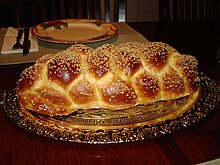
The dough ofchallah(calledbarkhesin Western Yiddish) is often shaped into forms having symbolical meanings; thus onRosh Hashanahrings and coins are imitated, indicating "May the new year be as round and complete as these"; forHosha'na Rabbah,bread is baked in the form of a key, meaning "May the door of heaven open to admit our prayers."[citation needed]
In Eastern Europe, the Jews baked black (proster,or "ordinary" ) bread, white bread andchallah.The most common form is the twist (koilitchorkidkefrom theRomanianwordîncolăciwhich means "to twist" ). Thekoilitchis oval in form and about one and a half feet in length. On special occasions, such as weddings, thekoilitchis increased to a length of about two and a half feet.
Thebagel,which originated inJewish communities of Poland,is a popular Ashkenazi food and became widespread in theUnited States.[17][18]
Fats[edit]
The rendered fat of chickens, known asschmaltz,is sometimes kept in readiness for cooking use when needed.Gribenesor "scraps", also calledgriven,the cracklings left from the rendering process were one of the favorite foods of the former Jewish community in Eastern Europe.Schmaltzis eaten spread on bread.
Fish[edit]

With kosher meat not always available, fish became an important staple of the Jewish diet. In Eastern Europe it was sometimes especially reserved forShabbat.As fish is not considered meat in the same way that beef or poultry are, it can also be eaten with dairy products (although someSephardimdo not mix fish and dairy).
Even though fish isparve,when they are served at the same meal, Orthodox Jews will eat them during separate courses and wash (or replace) the dishes in between.Gefilte fishandloxare popular in Ashkenazi cuisine.
Gefilte fish(from Germangefüllte"stuffed" fish) was traditionally made by skinning the fish steaks, usuallyGerman or French carp,de-boning the flesh, mincing it and sometimes mixing with finely chopped browned onions (3:1), eggs, salt or pepper and vegetable oil. The fish skin and head were then stuffed with the mixture and poached.[19]
The religious reason for a boneless fish dish for Shabbat is the prohibition of separating bones from food while eating (borer).

A more common commercially packaged product found today is the "Polish" gefilte-fish patties or balls, similar toquenelles,where sugar is added to the broth, resulting in a slightly sweet taste.[20]Strictly speaking they are the fish filling, rather than the complete filled fish.[21]This method of serving evolved from the tradition of removing the stuffing from the skin,[22]rather than portioning the entire fish into slices before serving.
While traditionally made withcarpor whitefish and sometimespike,gefilte fish may also be made from any large fish:cod,haddock,orhakein the United Kingdom.
The combination ofsmoked salmon,or whitefish withbagelsandcream cheeseis a traditional breakfast or brunch inAmerican Jewish cuisine,made famous atNew York Citydelicatessens.
Vorschmackorgehakte hering(chopped herring), a popular appetizer on Shabbat, is made by chopping skinned, bonedherringswith hard-boiledeggs,sometimesonions,apples,sugarorpepperand a dash ofvinegar.
Meat[edit]
Holishkes,stuffed cabbage, also known as thecabbage roll,is also a European Jewish dish that emerged from more impoverished times for Jews. Because having a live cow was more valuable than to eat meat in the Middle Ages, Jews used fillers such as breadcrumbs and vegetables to mix with ground beef. This gave the effect of more meat being stuffed into the cabbage leaves.
A spread ofchopped liver,prepared withcaramelized onionsand often includinggribenes,is a popular appetizer, side dish, or snack, especially among Jews on the east coast of North America. It is usually served with rye bread or crackers.
Gebratenes(roasted meat), chopped meat andessig-fleisch(vinegar meat) are favorite meat recipes. Theessigor, as it is sometimes called,honigorSauerbraten,is made by adding to meat which has been partially roasted some sugar, bay leaves, pepper, raisins, salt and a little vinegar.Knishis a snack food consisting of a meat or potato filling covered with dough that is either baked or grilled.
Side dishes[edit]
Tzimmesgenerally consists of cooked vegetables or fruits, sometimes with meat added. The most popular vegetable is the carrot (mehren tzimes), which is sliced. Turnips are also used fortzimmes,particularly in Lithuania. In southern Russia, Galicia and Romaniatzimmesare made with pears, apples, figs, prunes or plums (floymn tzimes).
Kreplachareravioli-like dumplings made from flour and eggs mixed into a dough, rolled into sheets, cut into squares and then filled with finely chopped, seasoned meat or cheese. They are most often served in soup, but may be fried.Kreplachare eaten on various holidays, includingPurimandHosha'na Rabbah.
Soups[edit]

A number of soups are characteristically Ashkenazi, one of the most common of which ischicken souptraditionally served onShabbat,holidays and special occasions. The soup may be served with noodles (lokshenin Yiddish). It is often served withshkedei marak(lit. "soup almonds", croutons popular in Israel), calledmandlenormandlachorperelachin Yiddish. Other popular ingredients arekreplach(dumplings) and matza balls(kneidlach)—a mixture of matza meal, eggs, water pepper or salt. Some reservekneidlachforPassoverandkreplachfor other special occasions.
In the preparation of a number of soups, neither meat nor fat is used. Such soups formed the food of the poor classes. An expression among Jews of Eastern Europe,soup mit nisht(soup with nothing), owes its origin to soups of this kind.
Soups such asborschtwere considered a staple inUkraine.Shtshav,a soup made with sorrel, was often referred to as "green borscht" or "sour grass".[23]Soups likekrupnikwere made of barley, potatoes and fat. This was the staple food of the poor students of theyeshivot;in richer families, meat was added to this soup.
At weddings, "golden" chicken soup was often served. The reason for its name is probably the yellow circles of moltenchicken fatfloating on its surface. Today, chicken soup is widely referred to (not just among Jews) in jest as "Jewish penicillin", and hailed as a cure for the common cold.[24]
There are a number of sour soups in the borscht category. One iskrautor cabbage borscht, made by cooking together cabbage, meat, bones, onions, raisins, sour salt (citric acid), sugar and sometimes tomatoes.
Beet borscht is served hot or cold. In the cold version, a beaten egg yolk may be added before serving and each bowl topped with a dollop of sour cream. This last process is calledfarweissen(to make white).
Krupnik, or barley soup, originates in Polish lands; its name comes from the Slavic term for hulled grains,krupa.While non-Jewish recipes for krupnik often involve meat (beef, chicken, pork or a mixture) and dairy (sour cream) in the same recipe, Jewish recipes for meat-based krupnik generally use chicken or (more rarely) beef broth; if made without meat, sour cream may be added.[25]
Sweets and confections[edit]

Teiglach,traditionally served onRosh Hashanah,the Jewish New Year, consists of little balls of dough (about the size of a marble) drenched in a honey syrup.Ingberlachare ginger candies shaped into small sticks or rectangles.Rugelach,babka,andkokoshare popular pastries as well.
In Europe, jellies and preserves made from fruit juice were used as pastry filling or served with tea. Among the poor, jelly was reserved for invalids, hence the practice of reciting the Yiddish sayingAlevay zol men dos nit darfn(May we not have occasion to use it) before storing it away.
Flodni,a layered sweet pastry consisting of apples, walnuts, currants and poppy seeds, were a staple ofHungarian Jewishbakeries prior toWorld War II.
Because it was easy to prepare, made from inexpensive ingredients and contained no dairy products,compotebecame a staple dessert in Jewish households throughout Europe and was considered part of Jewish cuisine.[26]
Gallery[edit]
-
Chocolate rugelach
-
Bagel with lox, cream cheese, and capers
-
Cholent
-
Half sour and full sour fermented cucumber pickles
-
Chicken broth with kreplach (soup dumplings)
-
Kasha varnishkes
-
Holishkes (cabbage rolls)
-
Gefilte feffers (stuffed peppers)
-
Cheese blintzes with blackberry preserves
-
Varenikes (dumplings with fruit preserves)
-
Krupnick (barley and mushroom) soup
-
Shtshav (sorrel soup)
-
Shashlikcooked outdoors
-
Fresh curd cheese
-
Fruit preserves
-
Tzimmes with sweet potato and pear
-
Gefilte fishquenelles
-
Pontshkes(jelly doughnuts)
-
Cucumber salad with dill and onions
-
Arbes (boiled chickpeas)
See also[edit]
- List of Ashkenazi Jewish restaurants
- American Jewish cuisine
- Sephardic Jewish cuisine
- Mizrahi Jewish cuisine
- Ethiopian Jewish cuisine
- Syrian Jewish cuisine
- Israeli cuisine
- Yemenite Jewish cuisine
- Ancient Israelite cuisine
- Jewish cuisine
- French cuisine
- German cuisine
References[edit]
- ^Nathan, Joan.King Solomon's Table.
- ^Marks, Rabbi Gil.The Encyclopedia of Jewish Food.
- ^"Ashkenazi Cuisine".My Jewish Learning.70 Faces Media.Retrieved22 October2022.
- ^Mosk (2013), p. 143
- ^Bauer, Ela."Guilds".YIVO Encyclopedia.YIVO.Retrieved22 October2022.
- ^Landsburg, Steven E. (13 June 2003)."Why Jews Don't Farm".Slate.Retrieved22 October2022.
- ^Headrick, Isabelle S. (15 March 2021)."A Family Fight on the Bosporus: The Ashkenazi Jews of the Ottoman Empire".Not Even Past.Retrieved22 October2022.
- ^"The Hirshon Romanian-Jewish Garlic Beef" Sausages "– Karnatzlach".The Food Dictator.24 March 2019.Retrieved22 October2022.
- ^Wex, Michael (2016).Rhapsody in Schmaltz: Yiddish Food and Why We Can't Stop Eating It.New York: St. Martin's Press. pp. 16–17.ISBN978-1-250-07151-4.
- ^Haber, Joel (27 April 2022)."Ashkenazi Food: Unrecognized Diversity".A Taste of Jew.Retrieved22 October2022.
- ^Wex, Michael (2016).Rhapsody in Schmaltz: Yiddish Food and Why We Can't Stop Eating It.New York: St. Martin's Press. p. 116.ISBN978-1-250-07151-4.
- ^Schoenfein, Liza (March 2, 2023)."Could this be the most underrated ingredient in all of Jewish cooking?".The Forward.Retrieved2 March2023.
- ^Kirshenblatt-Gimblett, Barbara."Food and Drink".YIVO Encyclopedia.YIVO.Retrieved22 October2022.
- ^Haber, Joel (27 April 2022)."Ashkenazi Food: Unrecognized Diversity".A Taste of Jew.Retrieved22 October2022.
- ^Koenig, Leah (20 April 2016)."As American as Pot Roast and Potato Salad".Tablet Magazine.Retrieved22 October2022.
- ^Kaplan, Ben (5 February 2020)."Reclaiming Food, Reclaiming History".eJewish Philanthropy.Retrieved22 October2022.
- ^Filippone, Peggy Trowbridge.“Bagel History: Bagels date back to the 1600s”Archived2016-05-18 at theWayback Machine,About.com website, retrieved March 27, 2013.
- ^Altschuler, Glenn C. (2008).”Three Centuries of Bagels”,a book review of:'The Bagel: The Surprising History of a Modest Bread', by Balinska, Maria, Yale University Press, 2008,Jewish Daily Press website, published on-line November 05, 2008 in the issue of November 14, 2008
- ^Попова, М. Ф.,Секреты Одесской кухни,Друк, Одесса, 2004, p.163 (Russian); Popova M.F.,Secrets ofOdesakitchen, Druk, Odesa, 2004, p.163
- ^Satz, Miriam,Heirloom cookbook: recipes handed down by Jewish mothers and modern recipes from daughters and friends,Kar-Ben, 2003, p.14
- ^Goodman, Hanna,Jewish cooking around the World: gourmet and holiday recipes,Varda Books Skokie, Illinois, 2002, p.147
- ^Garfunkel, Trudy,Kosher for everybody: the complete guide to understanding, shopping, cooking, and eating the kosher way,John Wiley & Sons, Inc., 2004, p.11
- ^Polis, Jared."Schav (Sour Grass)".Jewish Food Experience.Retrieved22 October2022.
- ^"Jewish penicillin definition".Medterms.Com.Medicine Net.Com, a WebMD Company. Archived fromthe originalon 2012-08-01.Retrieved2012-07-12.
- ^Romanow, Katherine."Eating Jewish: Krupnik (Polish Barley Soup)".Jewish Women's Encyclopedia.Retrieved31 October2022.
- ^Be Merry / A taste of Poland,Haaretz
.


